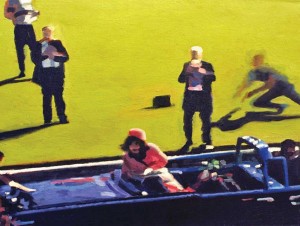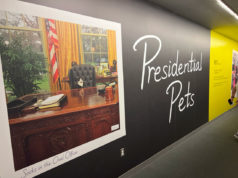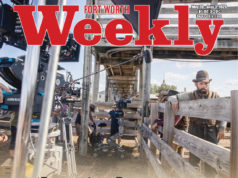Fort Worthian Leslie Lanzotti describes her painting style as “fractured reality.” Fitting then that one of her favorite subjects is shrouded in mystery.
And not just any big question but one of the biggest in the history of the United States.
Painter Dennis Blagg, her friend and the curator of her current show at the Fort Worth Contemporary Arts Center, was 12 years old and living with his family in Dallas at the time of President John F. Kennedy’s assassination.
“This was something that always stuck with me,” the Fort Worth naturalist master said, “and there are a lot of questions that just begged to be answered. … As a child, I was deeply horrified.”
To mark the 50th anniversary of the shooting this year, Blagg and Lanzotti have put together JFK: A Fractured Reality. The collection of about two dozen pieces based mostly on televised imagery from that fateful day is beautiful in the worst ways and somewhat blackly comedic.
There’s no telling what Lanzotti and Blagg are going for, but the smart money’s on the fact that Blagg is pretty convinced that there’s way more to the assassination than what we’ve been told. “There are two official government studies on the subject,” Blagg said. “One says [Lee Harvey] Oswald did it. The other said there was a conspiracy.”

Based on what we’ve seen over the years of Lanzotti’s JFK oeuvre –– she’s been working on these pieces for years –– the ones that Blagg has chosen for JFK are of a highly skeptical bent. In one piece, the text on the canvas and the imagery (four men in black trench coats with their backs to the viewer walking on the grass down Elm Street) suggest that “men in black” kept spectators from looking beyond the grassy knoll after the shots were fired. In another, we learn that Allen Dulles, the CIA chief whom Kennedy fired, met secretly with LBJ about the “BIG EVENT.”
Working from various sources, Lanzotti makes her point. Loudly. Her insistence that the U.S. government is untrustworthy nearly completely overshadows the best part of the exhibit: the painter’s brilliant and brilliantly distinct style.
Observing a typical Lanzotti is like looking at a television screen from far away. Up close, it’s a semi-abstraction. In just a few broad strokes, she makes details sing. In one painting, Jackie Kennedy’s face is a collection of four black lines, just four, but there is no doubt that it is Jackie Kennedy. By being able to set off her subjects’ features precisely, Lanzotti is able to bring Jackie –– and JFK and LBJ and Oswald and everyone else who’s part of the sad tale –– stunningly to life.
Life in all of its tragicomic glory, that is. Inspired by the actual comic book Superman’s Mission for President Kennedy, Lanzotti, down to the last Ben-Day dot, shows the Man of Steel warning “Jack” about Dallas. Funny in a cute way? Yes, but what may be funny-cute for us, ensconced as non-presidents of the most powerful nation in the history of the world in the safe, comfortable 21st century, may still be cruel and harsh for some folks, Dennis Blag included.
Back to that message. As you read along, you might not even notice that Lanzotti has gone to the trouble of making the words look exactly as they would on the pages of a book. What takes us 10 seconds to read probably took her 10 hours to paint. Should we care? Painting is not supposed to engage our brains so intensely, right? Well, we probably shouldn’t care, but it would be a mistake to overlook her painstaking attention to detail.
The televised imagery clearly had an impact on the painter. LBJ’s swearing in is rendered in the gooey black and white of an old photograph that’s been Xeroxed one too many times. Walter Cronkite’s downcast visage is made up of several dozen gloriously swirling amoebae of grays and beiges. And Kennedy’s black Cadillac, its lines glowing white from the sun, crawls down Elm Street toward fate.
We care about contemporary painting, and a Leslie Lanzotti show should be high on your list of exhibits to see. Blagg also believes we should care about the content of JFK.
“I think it’s time for something like this,” he said. “I think it’s a contemporary subject that crosses the subculture of the country.”












